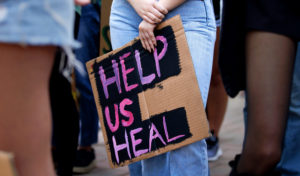“Let’s go to page seven,” says the psychologist.
I flick through the papers on my lap. There it is, at the bottom: “Autism, without accompanying intellectual impairment and without accompanying language impairment.” I read that I fulfil all seven diagnostic criteria for what used to be known as Asperger’s Syndrome. In fact, on one of the rating scales where a score of more than 77 points supports a diagnosis, I come in at 154. I feel I’ve done well, by being such a clear-cut case.
Then, my past unfolds. It’s like watching a film with a twist at the end. The signs were there all along: literal thinking, obsessive interests, anxiety, struggles with change. I have always known that I’m autistic. And yet, I haven’t had a clue.
The assessment that led up to my diagnosis lasted for three months. The psychologist interviewed me and spoke to my close family; I did tests and filled out questionnaires. The self-report inventories were a little antiquated in their view on autism, the psychologist told me apologetically. He was right. The questions were based on stereotypical male interests, such as playing boardgames, noticing number plates on cars, or collecting information about different categories of trains.
I envisioned the person whom the questionnaire was aimed at: an anaemic male gamer who rarely leaves his apartment, collects soda cans, can solve a Rubik’s cube in under a minute and monotonously drones on and on about the Cretaceous period. I thought about male geeks in popular culture, characters in TV shows like The Big Bang Theory or Atypical.
Until the Nineties, autism was regarded as a condition mostly found in boys — simply because all the early scientific research on autism was done on boys and men. This gender imbalance meant the diagnostic tools established were skewed. Doctors such as Hans Asperger noted that the boys he examined had limited, strong interests, and came to the conclusion that this was an autistic trait. Therefore, only “boyish” special interests came to be associated with autism.
In 1992, the Swedish child psychiatrist Svenny Kopp — one of the first authors to write a scientific article arguing that there were more autistic girls than previously believed — noticed that if a girl was obsessed with, for example, My Little Pony, her male colleagues wouldn’t recognise this as an autistic special interest. Instead, the girls were given other, less specific diagnoses like Semantic Pragmatic Disorder or “learning difficulties”. Autism was only recognised in a girl if the case was very severe.
Medicine did ask itself, at the time, why there seemed to be no girls with so-called “high-functioning” autism — that is, autism without accompanying intellectual impairment. The explanation, doctors decided, was that girls must have to experience a more extensive brain injury, a more profound intellectual disability, before they could develop autism. But Svenny Kopp didn’t buy it. Being female herself was pivotal to her scepticism, she says today. Her ground-breaking thesis, “The Girl Project”, showed that not all autism looks like the kind observed in boys. She is currently conducting a follow up-study of the girls she worked with in the Nineties, who are all now around 35. Her work has received an incredible amount of attention — and offered salvation to many autistic women.
Autistic women are often good at masking their social shortcomings, because from a young age girls tend to be drilled harder in social intercourse than boys. Masking happens unconsciously, and from an early age; children with autism withdraw and make themselves invisible, as they carefully observe the play and speech of their fellows, before attempting to copy them.
When I was a child, my peers sometimes resented me without me understanding why. I realised that I must have been misunderstood somehow, but couldn’t see when or how. A fear took root in me. Without knowing it, I studied social interaction through the books, TV shows, plays and films that I devoured. I began to minimise risks in my friendships by letting others make decisions, so that no one would get annoyed. I often found myself in constellations that may have looked like a trio from the outside, but were really two best friends and one backup: me. I listened, asked questions, said yes to every suggestion, expressed almost no needs of my own, kept confidences but rarely offered any in return, and became everyone’s most amenable friend.
Girls with autism are often interpreted as “sweet”, shy and acquiescent. They don’t take up space in a group or stir up trouble. By adulthood, their masking can be so honed that they become social chameleons, who blend in seamlessly in any company. But the long-term suppression of their own true self often leads to exhaustion and poor mental health. Those who seek out an assessment almost always have a history of anxiety and depression, my psychologist tells me. If you don’t interpret reality in the same way as those around you, of course you will feel unwell. Research published in the British Journal of Psychiatry states that, in the UK, “10% of those who died by suicide had evidence of elevated autistic traits, indicating likely undiagnosed autism”.
Nevertheless, moving through the world without masking at all is near-impossible for an autist. There would be too many conflicts and misunderstandings, as neurotypical people have a hard time grasping that not everyone is like them. In search of relief, as an adolescent I spent all my time at the stable. My relationship with horses felt peaceful and undemanding compared to my relationships with other people. I couldn’t decipher the codes, couldn’t understand what was implied. It was as though something went on between others that was imperceptible to me — something subtle and ever-changing.
The more “high functioning” you are, the easier it is to study expected behaviours, mask your autism and behave on the majority’s terms — in social relationships, in the schoolyard, and on the job market. After university, I transformed my special interests into a profession and started working in radio and television. There, communication was simpler; there were rules. You wrote a script before speaking and all you had to do was read it aloud. No one was allowed to interrupt. When the green light came on in the studio, the floor was mine.
But the better you are at “acting normal”, the less seriously you will be taken when explaining your difficulties. “Intelligence can compensate for so much,” the artist Linn, who was diagnosed at age 22, told me. The way her strengths have obscured her difficulties has been a constant frustration in her life. “If I hadn’t been so smart, they might have noticed something sooner. When others perceive you as intellectually clever, they struggle to understand that you can have all these problems. It doesn’t add up that someone who is good at thinking can fail so utterly at things that are easy for others.”
After my assessment, I searched for books on autism in grown women, but couldn’t find many. Most books focused on children and adolescents, but autism is not something you grow out of. You can get better at coping, but it can’t be trained away and there is no medication. It is a life-long condition.
And so, I decided to write a book to fill the silence, The Autists: Women on the Spectrum. I interviewed autistic women in Sweden, including Linn. Their stories echoed mine: growing up feeling different without understanding why; experiencing bullying in school and constant misunderstandings in communication with others; suffering from depression and anxiety as an adult; and then finally finding peace in being given the right diagnosis.
Autism has always been present in humanity, according to neurologists such as Oliver Sacks. But throughout history, the language used to describe autistic people has varied, from “withdrawn” and “eccentric” to “odd”. The earliest descriptions of what is thought to be autism date back to the 13th century, and refer to the Italian monk Brother Juniper, one of the Grey Friars in St Francis’s following. Of course, we can never be sure about a posthumous diagnosis, but scientists have researched the lives of famous historical individuals — using source materials such as diaries, letters, testimonies from relatives and medical assessments — and tried to determine whether they might have received an autism diagnosis had they been alive today. Women often mentioned are poet Emily Dickinson, philosopher Simone Weil and author Patricia Highsmith.
But autism as a concept wasn’t born until the early 20th century — and back then it only really applied to men. To have grown up with undiagnosed autism is to have suffered difficulties that didn’t exist. I close my eyes and rewind my own tape again, seeing the clues from my childhood and teenage years and life as a young adult. What if I had known sooner? How would my life have turned out? I tell myself that the alternative is impossible: during my childhood, female autists without intellectual impairment, as a recognised category, didn’t exist. No one could have given me a diagnosis. My life thus far is not a series of years lost. But still, I mourn not being able to decipher the signs before. I repressed everything that was true in me, and kept striving towards further defeat.
My diagnosis is the best thing that has happened for my self-esteem. After the assessment, I went from failed neurotypical to regular autist. I understood who I was, and the relief was indescribable. My anxiety receded, and I lowered my dosage of antidepressants. I started to like my quirky sides. I found the strength to say no to things I had previously thought I must do. I shrunk my life, peeling away things and musts, protecting everything that made me feel good. I became proud of my difference.
It’s a new year. One day when parents are invited to join the children in class, I visit my daughter’s school. I watch the children colour in drawings of animals. When the bell rings for lunch, we walk to the canteen, where chilli fish and boiled potatoes are on the menu. We choose the table in the farthest corner. Sitting there, alone, is a girl from another class. I take a seat across from her. On her plate are three pancakes. No toppings. She looks at me.
“I get to eat this because I’m autistic,” she says, and puts a piece of pancake in her mouth.
“Me too,” I say.
Disclaimer
Some of the posts we share are controversial and we do not necessarily agree with them in the whole extend. Sometimes we agree with the content or part of it but we do not agree with the narration or language. Nevertheless we find them somehow interesting, valuable and/or informative or we share them, because we strongly believe in freedom of speech, free press and journalism. We strongly encourage you to have a critical approach to all the content, do your own research and analysis to build your own opinion.
We would be glad to have your feedback.
Source: UnHerd Read the original article here: https://unherd.com/




